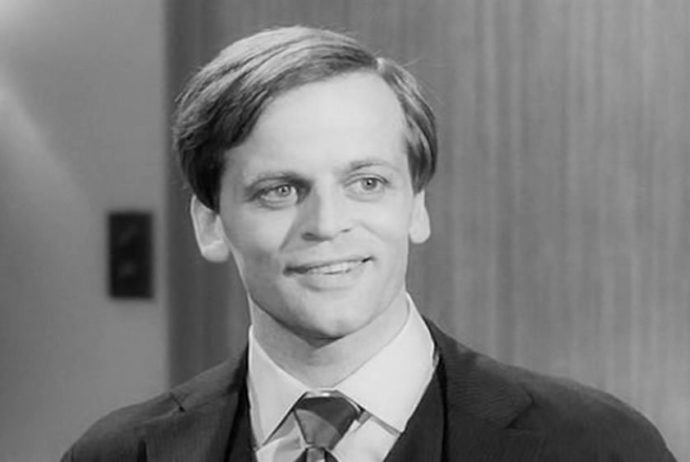Dir: Ákos Ráthonyi
Star: Joachim Fuchsberger, Sabina Sesselmann, Christopher Lee, Klaus Kinski
Probably the most interesting thing about this krimi, is it was shot in two entirely separate versions: one in German, and one in English, in a co-production with British studio Omnia Pictures. The latter movie was called The Devil’s Daffodil, a slightly more catchy title than the German one, which translates as “The secret of the yellow daffodils” The movies have different lead actors, but a number of the same supporting cast, including Lee and Marius Goring, who appear in both [According to Wikipedia, Lee spoke five languages fluently – English, Italian, French, Spanish, and German – as well as being “moderately proficient” in three more, Swedish, Russian, and Greek]
The plot in both is the same, and focuses on two different crimes. In London, someone is killing attractive young ladies, and leaving yellow daffodils at the scene of the murder. Meanwhile, in Hong Kong, airline security consultant Jack Tarling (Fuchsberger) discovers heroin being smuggled inside the stems of… artificial yellow daffodils. He flies to London to visit the import-export company for whom the shipment was intended, only to find that all documentation regarding the order has mysteriously been lost. At first, company secretary Anne Ryder (Sesselmann) seems to remember it, but she suddenly clams up, under orders from her boss, Raymond Lyne.
When the employee responsible is fished out of the Thames, very bereft of life, the investigation has to make its way past this literally dead-end. But it turns out that there is another angle which Tarling can explore: all the murdered women worked at the somewhat questionable “Cosmos Club”, a bar and cabaret. For it turns out, there is a link between the psycho killer and the heroin smuggling. Tarling gets help from Scotland Yard – who knew they were so happy to let a private security consultant basically run a criminal investigation? There’s also Ling Chu (Lee), a Hong Kong policeman who was involved in the smuggling case back East. It turns out he has both a personal interest in the case, and not quite the same respect for suspects’ rights, as his Western colleagues.
Yes, Christopher Lee is not just speaking German, he’s portraying a German-speaking Chinaman. If this had been a random example, it might have been one thing [this was the sixties, after all, when even Mickey Rooney got to play an Asian]. But for whatever reason, it was something of a regular occupation for Lee in the decade. It started in 1961 with his portrayal of Chung King in Hammer’s Terror of the Tongs, and after his role here, he went on to play evil genius Fu Manchu no less than five times for producer Harry Towers between 1965 and 1969.

Kinski plays Peter Keene, a ne’er-do-well who is the son of Lyne’s former Royal Air Force commander. Lyne took the son under his wing, in what he claims is “Christian charity,” in an attempt to steer the young man out of the trouble and bad company into which he had fallen: “Debts, unfunded cheques, black market… He was a good for nothing. Wasn’t even a good criminal.” Lyne gives Keene a job as a barman at the Cosmos Club, but the young man is also useful as a tool for taking care of any problems Lyne needs handled. There also appears to be a significant dose of mental instability in Keene’s character, which plays right into Kinski’s wheelhouse, especially during the later stages.
In addition to being filmed at Shepperton Studios, there’s some nice location work here, both around Piccadilly Circus and in a finale at Highgate Cemetery, then largely abandoned and in a state of aesthetically pleasing disrepair. But that isn’t enough to salvage what seems a particularly poorly thought-out and executed plot. It’s difficult to figure out what anyone’s motives are here, and Tarling is blandly uninteresting as the hero. They’d have been better off making Ling the central character, as his refreshing lack of moral scruples might have made for an interesting twist. He’s also fun to watching, spouting “old Chinese proverbs,” that he freely admits are entirely made-up. This was the first of five times that Lee and Kinski would act in the same movie – although not necessarily sharing any screen time. The next occasion would be the following year, in the similarly horticulturally titled, Secret of the Red Orchid.
Outside of that pair, this is just not very interesting, though I was at least entertained by the burlesque show-tune which enlivens the middle of proceedings at the Cosmo Club. Their leading showgirl, “Mademoiselle Gloria”, chirps out a cheerful little ditty on stage to a pseudo-Parisian policeman, with lyrics such as “When a man sees me, he immediately thinks about I’amour – because I’m totally natural.” All the while, she keeps popping behind a pseudo-Parisian hoarding to remove items of her clothing. It’s entirely PG-rated, and you can hardly imagine anyone finding it erotic, but it does have a certain innocent charm. More than one source indicates that Kinski’s autobiography has him reporting he slept his way through most of the female cast and crew here – one imagines Mademoiselle Gloria was near the top of his list.
I’ll have to dig out my copy and see if I can find the relevant passage…
